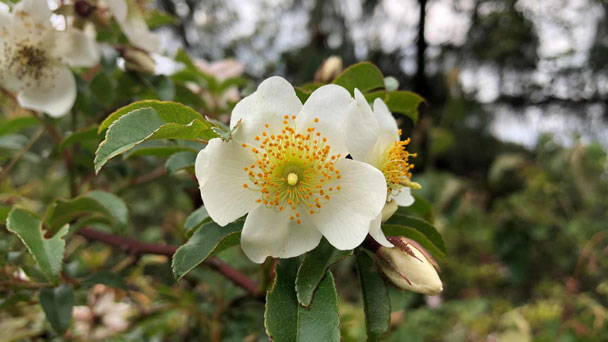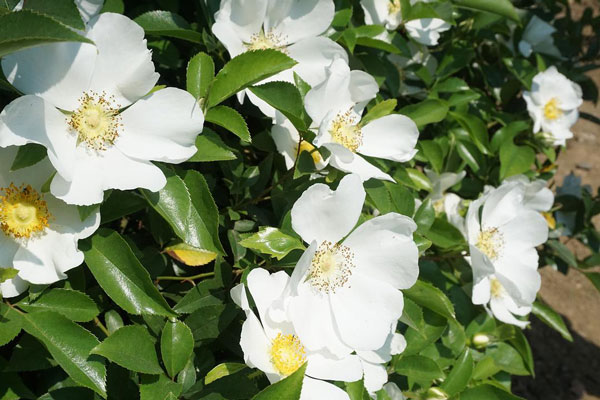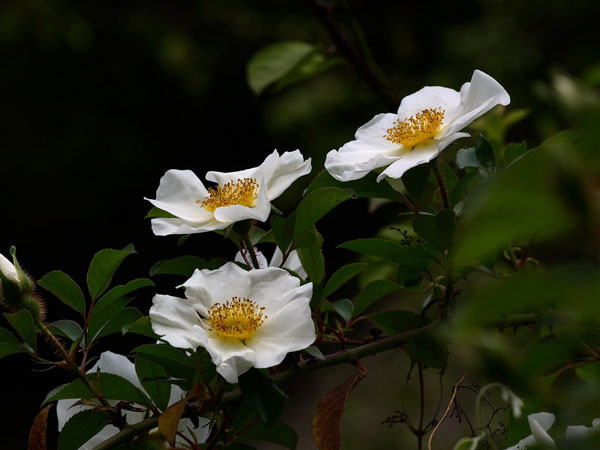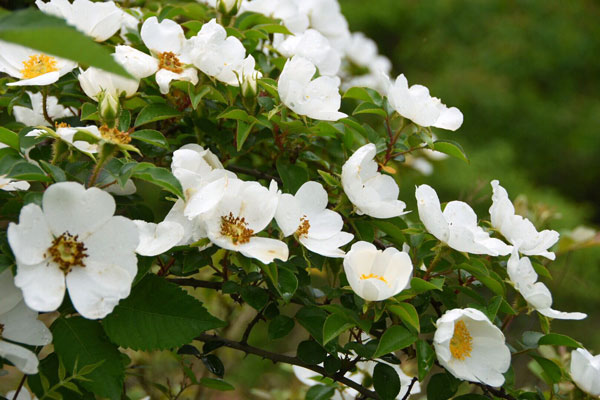Cherokee Rose: Grow & Care for Rosa laevigata
Written by Iris
Dec 23 2021

Cherokee rose (Rosa laevigata) is a climbing rose native to fields, shrubs, farms, and low-altitude mountains in China. Cherokee rose was first brought to the United States in the early colonial era. This is an evergreen (in mild climates) climber that grows from 6 to 20 feet long on arched stems with hooked spines. It can also be planted as a sprawling independent shrub. The stem is covered with three-leaved dark green leaves with coarsely toothed leaflets. Single fragrant white flower with fan-shaped petals and yellow stamens, Cherokee rose blooms for a few weeks in spring.

| Botanical/Scientific Names | Rosa laevigata |
| Common Names | Cherokee Rose, Rosa Mosqueta Cherokee, Cherokee Rose Musquée, Fructus Rosae Laevigatae, Chinese Rosehip, Jin Yin Zi, Jinyingzi, Rosier des Cherokees |
| Native Area | Asia (Central and Southern China to Taiwan, Laos and Vietnam) |
| Plant Type | Perennial climbing rose shrub |
| Mature Size | 6 to 20 feet tall; 3 to 15 feet wide |
| Bloom Time | Early to late spring or early summer |
| Flower Color | Single fragrant white flower with fan-shaped petals and yellow stamens |
| Flower Fragrance | clove-like fragrance |
| Lighting Requirements | Full sun |
| Soil Care | Clay, Loam, Sand |
| Propagation | Can be propagated from seeds or cuttings |
| Poisonous | There is a layer of hairs around the seeds just beneath the flesh of the fruit. These hairs can cause irritation to the mouth and digestive tract if ingested. |
How to Grow Cherokee RoseCherokee Rose Propagation from SeedsCherokee Rose Propagation from CuttingsHow to Care for Cherokee RoseCherokee Rose Light RequirementsSoil for Cherokee RoseCherokee Rose WateringFertilizer for Cherokee RosePruning Cherokee RoseCherokee Rose Pests & Diseases CareCherokee Rose Care FAQWhat is Cherokee Rose used for?Is Cherokee rose Poisonous?What does Cherokee Rose smell like?
How to Grow Cherokee Rose
Cherokee Rose Propagation from Seeds
Cherokee Rose seed often takes two years to germinate. This is because it may need a warm spell of weather after a cold spell in order to mature the embryo and reduce the seedcoat. One possible way to reduce this time is to scarify the seed and then place it for 2 - 3 weeks in damp peat at a temperature of 27 - 32°c (by which time the seed should have imbibed). It is then kept at 3°c for the next 4 months by which time it should be starting to germinate. Alternatively, it is possible that Cherokee Rose seed harvested 'green' (when it is fully developed but before it has dried on the plant) and sown immediately will germinate in the late winter. Seed sown as soon as it is ripe in a cold frame sometimes germinates in spring though it may take 18 months. Stored seed can be sown as early in the year as possible and stratified for 6 weeks at 5°c. It may take 2 years to germinate. Prick out the Cherokee Rose seedlings into individual pots when they are large enough to handle. Plant out in the summer if the plants are more than 25cm tall, otherwise grow on in a cold frame for the winter and plant out in late spring.Cherokee Rose Propagation from Cuttings
Cherokee Rose Cuttings of half-ripe wood with a heel, July in a shaded frame. Overwinter the plants in the frame and plant out in late spring. Cuttings of mature wood of the current seasons growth. Select pencil thick shoots in early autumn that are about 20 - 25cm long and plant them in a sheltered position outdoors or in a cold frame. The Cherokee Rose cuttings can take 12 months to establish but a high percentage of them normally succeed. Division of suckers in the dormant season. Plant them out direct into their permanent positions.How to Care for Cherokee Rose
Cherokee Rose Light Requirements
Consider planting on a south-facing, sunny, sheltered wall. While they will tolerate partial shade, the Cherokee Rose flowers (Rosa laevigata) thrive and resist disease in full sun.Soil for Cherokee Rose
While planting a garden plant, any passionate gardener should know the type of soil needed. Cherokee Rose soil type is Loam, Sand and the pH of soil is Acidic, Neutral. Different type of garden plants needs different type of soil. Also, some plants can be grown in a wide range of soil, so it is important to find the pH of soil. While planting, find Cherokee Rose Information where you will know everything about its leaf and flower color. According to plant season, the temperature requirements also differ. Another important characteristic of plant soil is the amount of water it should hold. Compare other garden plants for soil drainage and also share interesting Cherokee Rose Facts with other plant lovers. Sunlight is one of the essential factors for the growth of garden plants. In Cherokee Rose season find the kind of sunlight require for it and decide the location to plant it. Different types of sunlight that plants need include full sun, partial sun, partial shade,etc.Cherokee Rose Watering
Water a Cherokee rose in months with little rainfall. The leaves will turn yellow and wilt if they need watering. Place a soaker hose in a circle around the shrub about two inches inside the mulch ring. Turn the hose on low and water the mulch thoroughly with about 1 inch of water. One inch of water wets the soil to a depth of 12 inches. Depending on your type of soil, it can take from 30 minutes to 10 hours to obtain this level. When the water starts running off the edges of the mulch, the soil is no longer accepting the water and you can turn it off.Fertilizer for Cherokee Rose
Feed cherokee roses a balanced fertilizer like 10-10-10 when there are signs of new growth in early spring; feed again after the buds have set. Likely the fertilizer will come in granules. Spread them on the ring of mulch, following the directions on the package. Do not drop fertilizer on the trunk. Use a garden hose to water the fertilizer in thoroughly, until the granules dissolve.Pruning Cherokee Rose
Prune a Cherokee rose after the flowers are spent and the hips are dry in the late summer to fall. Put on leather gardening gloves to protect your hands from the sharp thorns. Hold a branch to prune with long tongs so as not to touch the thorns. Snip the branch off with pruning shears in the other hand. Prune the shrub back to the area that it should occupy. Remove the sides first to fit your trellis or fence line and then trim the top horizontally to your desired height.Cherokee Rose Pests & Diseases Care
Cherokee rose is generally not susceptible to the disease and insect pests that attack many of the hybrid roses. Insect pests include aphids, beetles, borers, scale, spider mites, thrips, rose midges and leafhoppers. Potential disease problems include black spot, powdery mildew, and rust. To prevent foliar diseases avoid overhead watering and promote circulation promotes. Remove and destroy diseased leaves from plants, and from the ground around the plants both during the growing season and as part of a thorough cleanup during the dormant season. Will spread aggressively in certain parts of the southeastern U. S.
Cherokee Rose Care FAQ
What is Cherokee Rose used for?
Cherokee Rose Fruit is a traditional Chinese medicinal herb used as a health tonic, secure essence, decrease urination, stop vaginal discharge and astringe intestines to stop diarrhea. Cherokee Rose Fruit support the digestive system, boost the immune system, promote circulatory health and benefit the skeletal system.Is Cherokee rose Poisonous?
There is a layer of hairs around the seeds just beneath the flesh of the fruit. These hairs can cause irritation to the mouth and digestive tract if ingested.What does Cherokee Rose smell like?
Cherokee Rose flowers bloom in the early spring, but in favorable conditions, it will produce the flowers in the fall of the year, a second flowering of this hardy plant. The Cherokee Rose flowers have a clove-like fragrance.Latest Updated
- Benefits of Bugleweed - 7 Science-backed Health Benefits
- Bugleweed Dangers & Side Effects - Is It Poisonous?
- How to Plant Evergreen Trees - What You Should Know
- When to Plant Evergreens - Grow Guide for Evergreen Trees
- 12 Wonderful Evergreen Shrubs for Your Garden
- 12 Popular Evergreen Plants with Pictures for Beginners
- When And How To Prune A Lilac Bush Like a Pro
- How to Grow & Care for Lilac Vine (Hardenbergia Violacea)
- Japanese Lilac Tree (Syringa Reticulata) Care & Propagation Guide
- Shumard Oak Pros and Cons - What to Know
Popular Articles
- Winter maintenance of Antirrhinum Majus
- How to Grow Terminalia Mantaly Tree
- How to Grow and Care for Crossostephium Chinense
- How to grow Antirrhinum Majus in spring
- Peristeria Elata (Dove Orchid) Profile: Info & Care Guide
- Underwatered Snake Plant (Sansevieria Trifasciata) - Signs And How To Fix
- How to Care for Brazilian Jasmine Plant (Mandevilla Sanderi)
- How to Grow & Care for Graptopetalum Purple Delight in Summer
- Rosa Chinensis (China Rose): Plant Growing & Care Tips
- How to Care for Baby Sun Rose (Aptenia Cordifolia)

